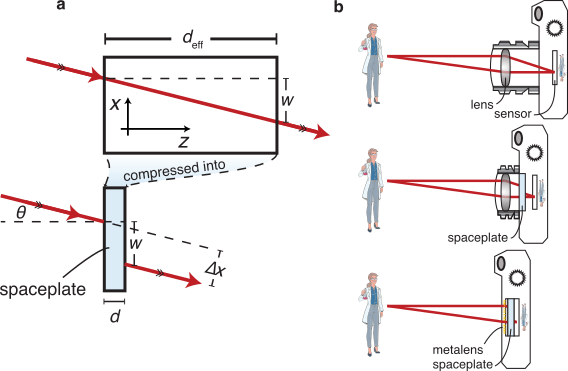A novel optical element will one day enable composite lenses and telescopes in a form factor small enough to fit in a pocket. The device, developed by Orad Reshef and Jeff Lundeen of the University of Ottawa, is called a spaceplate. Its function, say its developers, is to mimic the empty space needed to focus an image — meaning one day photographers will be able to take pictures of faraway subjects without lugging around a long-barrel telephoto lens.
“A spaceplate is an optical element that propagates light for a distance that exceeds its thickness,” Lundeen told Photonics Media in an email correspondence to which he and Reshef contributed. “From the perspective of a beam of light, after traveling through a spaceplate, it acts as if it has traveled through a thicker region of space.”

Operating principle of a spaceplate (a). A spaceplate can compress a propagation length of deff into a thickness d. For example, a beam incident on the spaceplate at angle θ will emerge at that same angle and be transversely translated by length w (resulting in a lateral beam shift Δx), just as it would for deff of free space (b). Adding a spaceplate to an imaging system such as a standard camera (top) will shorten the camera (center). An ultrathin monolithic imaging system can be formed by integrating a metalens and a spaceplate directly on a sensor (bottom). Courtesy of Orad Reshef and Jeff Lundeen, University of Ottawa.
In an interview with the University of Ottawa, the scientists said that the conception of the idea stemmed from a conversation about the limitations of light manipulation with metasurfaces. Lundeen said that it would be interesting to manipulate light based on its angle.
Reshef, Lundeen said, was confident in his ability to design and fabricate a component that could perform the task. "I subsequently concluded the easiest goal would be to replace the space needed for spread, i.e., propagation,” Lundeen said in the interview.
The team worked for a few months on the concept, and Reshef and Lundeen presented different viable designs, demonstrating the flexibility in methods of achieving their goal.
“The operation performed by a spaceplate is the converse of that of a lens,” Lundeen told Photonics Media. “A ray transmitted by a lens will bend to a different angle as a function of its position on the face of a lens; a spaceplate on the other hand will laterally shift the position of a ray as a function of its incident angle. These responses are termed local and nonlocal responses, respectively.
“Practically, this means that a spaceplate does not actually form an image like a lens does, nor does it introduce its own magnification, since any parallel rays that enter a spaceplate will exit it parallel as well. What it does do, however, is shorten the distances necessary for images to form after transmission through a lens.”
To simulate empty space, the pair explained, they needed a method that could impart a phase dependent on the incident angle of a ray, which, technically, they said, is applying the principles of Fourier optics. In the paper, the pair engineered this type of response in a thin-film multilayer stack made of silicon and silica glass — similar to the materials used in antireflective coatings for lenses.
“This structure features multiple internal reflections which we design to translate the rays in exactly the fashion needed to make a spaceplate,” Lundeen said. “We also show that this response can also be obtained in two additional ways: One, for the extraordinary wave in a birefringent plate if the birefringent optic-axis is normal to the sides of the plate (this is an uncommon geometry to use birefringence in), and two, for an optical flat with a lower refractive index than the background medium.”
The technology breaks the usual trade-offs in imaging system design, the team explained, in terms of numerical aperture, focal length, magnification, and the number and size of pixels.
“So if they can be perfected, spaceplates will change the design of imaging devices of all kinds,” Lundeen said.
The technology is still in its infancy, though the team is developing the work further; Reshef told the University of Ottawa that it already has designs on increasing the compression factor from 5 to over 100 times, and to increase total transmission.
“To continue doing this, we need to come up with a completely new design paradigm,” he said.
Reshef and Lundeen noted there are a number of groups hard at work to develop the technology.
“There is currently a sort of arms race to come up with the right design rules for them,” Lundeen said. “A good design methodology for nonlocal optics will surely help us improve the spaceplate further, but will also enable many other new nonlocal applications, such as image edge detection, which has also been demonstrated quite recently.”
The work was published in Nature Communications (www.doi.org/10.1038/s41467-021-23358-8).